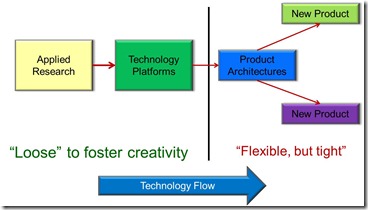 In a technology driven enterprise (like most polymer companies) having the right management approach in the early technology development phase is critical to get creativity and risk taking flowing. In the research or technology development work, failures are common, but remember “failures are opportunities to learn.” Research scientists will conduct many experiments learning incrementally as the project progresses. Since it is very difficult to map out timelines, this poses a management challenge. Customers are relentless in their demands for newer, better, cheaper products and they want them fast. Being closely coupled with the customer or market segments is critical to ensure you have the right technology platforms in the development pipeline. Let’s look at the overall technology development flow:
In a technology driven enterprise (like most polymer companies) having the right management approach in the early technology development phase is critical to get creativity and risk taking flowing. In the research or technology development work, failures are common, but remember “failures are opportunities to learn.” Research scientists will conduct many experiments learning incrementally as the project progresses. Since it is very difficult to map out timelines, this poses a management challenge. Customers are relentless in their demands for newer, better, cheaper products and they want them fast. Being closely coupled with the customer or market segments is critical to ensure you have the right technology platforms in the development pipeline. Let’s look at the overall technology development flow:
During the applied research and technology platform development phases there is a lot of uncertainty in how the work will progress. Some of the most important polymer inventions were a result of unexpected experimental outcomes. Teflon was discovered completely by accident by Dr. Roy Plunkett at DuPont Central Research labs. Finding a white powder in a tetrafluoroethylene gas cylinder was totally unexpected, but he had the foresight to analyze the properties. He discovered the substance was heat resistant and chemically inert, and had very low surface energy so that most other substances would not adhere to it. His discovery and subsequent exploration led to the commercialization of DuPont Teflon® now widely used in many anti-stick applications.
With this in mind, I advocate a “loose” management style in the technology development phase (or the “R” in R&D) to allow scientists to explore and have some freedom to follow unexpected leads. Technology managers must also realize that there are timelines to meet product development targets, so this is not an open invitation to just “play around.” Finding the right balance is one of the toughest management challenges in product development. Once you have your technology platforms completed, then with the transition to development of product architectures and ultimately new products requires a “flexible but tight” management approach. To the right of the bar in the figure is typically where a phase/gate (or Stage-Gate®) process is used. In this part of the product development process, there needs to be a bit more structure and timelines to ensure on-time delivery to the market or customers.
In the next post, we will discuss the details of technology platforms and give some examples of how technology platforms enable the creation of product architectures.
If you have a technology development challenge, contact InnoCentrix at 877-887-6596 and we can discuss how to delight your customers with great new products.


Leave a Reply